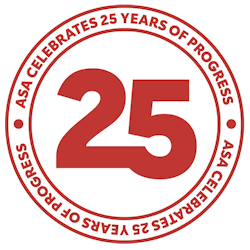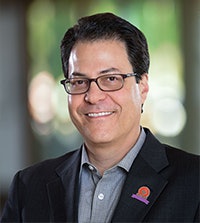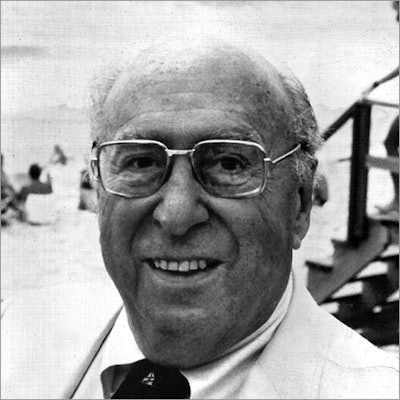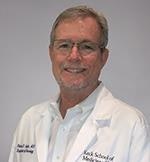The ASA at 25
Evolving organization rises to meet old and new challenges.

Power. Speed. Agility. For a 25-year-old athlete, those qualities are key to a winning performance.
As it turns out, they’re also vital as a 25-year-old organization works to turn the tide on stroke — in an era that may be among the most pivotal in the field’s history.
“The rapid change in stroke care now is similar to what was seen 20 or more years ago around heart attacks in cardiology,” said neurologist Mitchell Elkind, MD, MS, FAHA, the American Heart Association’s chief clinical science officer and a past chairman of the American Stroke Association’s national advisory committee. Mitchell Elkind, MD, MS, FAHA
Mitchell Elkind, MD, MS, FAHA
The American Stroke Association, launched in 1998 as a division of the American Heart Association, is driven by people power. That means millions of volunteers and donors are working to ensure equitable stroke care in all communities, funding innovative research, advocating for the public’s health and providing lifesaving resources.
Every day, the actions of the ASA are a powerful force in ensuring that mothers and fathers, sisters and brothers, daughters and sons who have a stroke get timely, optimal care, support, essential rehabilitative services and more.
Speed is an ever-present priority in the ASA’s work — from teaching the public to recognize strokes F.A.S.T. and call for help, to comprehensive systems-of-care initiatives that can shave off hours, minutes and seconds between when a stroke starts and when patients receive the therapies most likely to help them.
“The ASA taught everyone that ‘Time Is Brain’” — that is, the longer a stroke goes untreated, the more damage the brain is likely to sustain, Dr. Elkind said.
The pandemic, meanwhile, has stress-tested the ASA’s agility with unprecedented challenges. Scientists had to grasp — and quickly disseminate findings about — the particular dangers of strokes associated with COVID-19, along with the virus’s systemic, cerebrovascular and long-term effects. As anxiety and the COVID-19 death toll escalated, the public had to be persuaded not to neglect lifesaving cardiovascular care. And as the leading venue for stroke experts to share their knowledge, the International Stroke Conference had to march on, fully virtual in 2021 and in a hybrid in-person/online format since.
Decades of stroke focus
This year’s International Stroke Conference is a culmination of nearly 70 years of AHA interest in stroke, beginning with the organization’s leading role in developing the first Princeton Conference on cerebrovascular disease in 1954 — organized and chaired by Irving Wright, MD, the AHA’s 1952-1953 president.
 Irving Wright, MD
Irving Wright, MD
In the mid-1990s, the AHA’s leadership in stroke science was unmistakable, said Stroke Council Chair Patrick Lyden, MD, FAHA. Lyden was one of the investigators in the National Institute of Neurological Disorders and Stroke rt-PA Stroke Study Group — and helped draft the protocol and main results of a landmark 1995 trial that established intravenous recombinant tissue plasminogen activator as a vital treatment for ischemic stroke.
“Two years before the ASA was created, the AHA strongly endorsed the use of intravenous tPA in appropriately selected patients with acute ischemic stroke,” Dr. Lyden said. “This was a bold and controversial position, but it was based on hard science that has since been replicated many times.”
Subsequent publications on thrombolytic therapies “provide the medical community with the best, most informative updates on using this landmark therapy,” added Dr. Lyden, a professor of physiology and neuroscience and neurology at the University of Southern California’s Keck School of Medicine.
When the AHA’s Stroke Division was renamed the American Stroke Association, a Division of the American Heart Association, in 1999, then-AHA President Dr. Valentin Fuster wrote in Stroke, “The new name demonstrates that the AHA’s passion in the fight against death and disability from stroke is as strong as its fight against death and disability from heart disease.”
Guidance and insight
One way that passion takes flight is in the form of ASA consensus publications providing health care professionals and community leaders the latest expert guidance on stroke. The first such publication, predating the ASA, appeared in 1994 as a special report in Stroke on managing patients with acute ischemic stroke.
As the principal oversight committee for stroke-related activity of the ASA and AHA, the Stroke Council, through the work of several science subcommittees, commissions and approves such consensus publications.
Just in the past five years, ASA guidelines or scientific statements have addressed vital topics including stroke systems of care, management of spontaneous intracerebral hemorrhage, early management of acute ischemic stroke, prevention of new stroke after a previous stroke or transient ischemic attack, sex/gender differences in endovascular stroke treatment, and stroke management in infants and children.
Other recent notable publications have focused on primary prevention, the latest endovascular treatment guidance in early stroke, inclusion of stroke as a factor in cardiovascular risk prediction tools, adult stroke rehabilitation and recovery and defining optimal brain health in adults.
Meeting many communities’ needs
High among the ASA’s current priorities is health equity — ensuring that all people learn about stroke, receive preventive care and can access the best treatments for acute stroke, Dr. Elkind said. “This focus is driven by the recognition that stroke mortality is twice as high in Black as white people, and elevated in other communities with limited resources, including rural communities.”
Rural residents, along with American Indians, face the longest distances between their homes and certified stroke care, research has shown. Compared with people who live in urban areas, residents of rural areas are less likely to get the most advanced treatments for stroke and are more likely to die in the hospital.
The ASA also continues to highlight the importance of identifying and controlling high blood pressure, a condition affecting nearly 47% of U.S. adults. It’s the most important modifiable stroke risk factor, Dr. Elkind noted, responsible for half of all strokes and perhaps as many as 80% of bleeding strokes. (Breaking new ground in that fight is the AHA’s National Hypertension Control Initiative, a sweeping effort focusing on local health centers and community-based organizations to reduce high blood pressure in under-resourced areas.)
Other priority areas include evidence-based practice for stroke rehabilitation to improve recovery after stroke, and stroke risk factors such as atrial fibrillation — an irregular heart rhythm — and sickle cell disease, which is especially important as a cause of stroke in children.
Work in progress
Over a quarter-century, the ASA continually has proved that an association in motion stays in motion. The organization’s more recent achievements include:
· The launch of the open-access journal Stroke: Vascular and Interventional Neurology.
· A new research network on hemorrhagic stroke and an innovative collaboration to help reduce stroke disability and death rates in the southeastern U.S.
· The first international stroke center certification.
· A Thrombectomy-Capable Stroke Center certification, in collaboration with the Joint Commission.
· Phase III of Target: Stroke, setting more aggressive targets for timely treatment with alteplase as well as targets for prompt treatment with endovascular therapy.
· Expansion of the Get With The Guidelines® quality improvement initiative to address hemorrhagic stroke.
More than 3,600 hospitals have participated in Get With The Guidelines-Stroke since the program was launched with pilot testing in 24 hospitals in 2001. Currently through the program, about 86% of ischemic stroke patients have access to quality stroke care.  Patrick Lyden, MD, FAHA
Patrick Lyden, MD, FAHA
A future of possibilities
Back in the 1950s, the impetus for that first Princeton Conference came from medical activist and philanthropist Mary Lasker, who provided $25,000 in funding for the event with the aim of setting a national stroke agenda. Lasker’s parents both had experienced strokes and — as she recalled to neurologist James Toole, MD — a friend who had recently suffered a stroke was told there was no treatment besides bed rest.
Fast forward to today, where treatment approaches for stroke are multiple, treatment plans are multi-faceted and possibilities appear myriad. Among the developing areas Dr. Elkind finds most exciting are:
- Mobile stroke units, essentially ambulances with CT scanners, specialized lab equipment and access to a stroke specialist. These are designed to shorten the window between when a stroke begins and when patients receive crucial clot-busting care.
- The increasing use of therapy with stent-retrievers, which allow physicians to extract blood clots that cause strokes, thereby limiting resulting brain damage. “We are beginning to see the next stage in the evolution of these treatments to a wider group of patients: those with bigger strokes, those with strokes more than a day old, those who may be older or have other medical conditions,” Dr. Elkind said.
- A growing understanding of factors other than neurodegeneration that may contribute to cognitive decline — including tiny strokes, blood vessel disease, inflammation and even viral infections like COVID-19. Dr. Elkind sees a future where experts with more diverse backgrounds and skills collaborate on research into dementia. “The ASA,” he said, “will play a major role.”
Picture the people
Ultimately, progress against stroke relies on harnessing not just research data, but hearts and minds. Consider the untold volunteers participating in cerebrovascular clinical trials, on top of the 8 million stroke patients represented in the Get With The Guidelines-Stroke registry. Or the legions who champion stroke policy priorities — such as increased federal research funding or broader Medicare coverage for stroke — through the yourethecure.org grassroots advocacy network.
Add in the Stroke Heroes the ASA has celebrated, starting in 2020. And the 79,000-plus readers of its Stroke Connection magazine.
Then there are the millions of people educated by Together to End Stroke® or other awareness programs, the survivors and caregivers who have taken part in more than 1,300 ASA-registered stroke support groups, the tens of thousands of people aided by the Stroke Family Warmlinee and Support Network, and the more than two-thirds of adults who know at least one stroke warning sign.
All this, as researchers press on at the vanguard of stroke discovery. They include investigators who have contributed to the more than 3,000 stroke-related research projects funded by the AHA/ASA since 1998, and the variety of stroke experts assembled today for the International Stroke Conference.
“Here I have made lifelong working collaborations and friendships,” said Dr. Lyden, who has been an ASA member attending ISC since 1985. “The ASA provides the hub that brings together all spokes of stroke care and research.”






